
Brighton is a seaside resort and one of the two main areas of the city of Brighton and Hove in the county of East Sussex, England. It is located 47 mi (76 km) south of London. Archaeological evidence of settlement in the area dates back to the Bronze Age, Roman and Anglo-Saxon periods. The ancient settlement of "Brighthelmstone" was documented in the Domesday Book (1086). The town's importance grew in the Middle Ages as the Old Town developed, but it languished in the early modern period, affected by foreign attacks, storms, a suffering economy and a declining population. Brighton began to attract more visitors following improved road transport to London and becoming a boarding point for boats travelling to France. The town also developed in popularity as a health resort for sea bathing as a purported cure for illnesses.
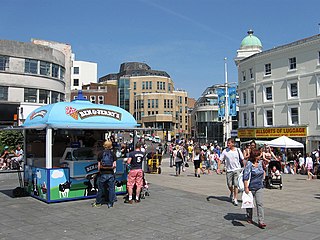
Brighton and Hove is a unitary authority with city status in East Sussex, England. There are multiple villages alongside the seaside resorts of Brighton and Hove in the district. It is administered by Brighton and Hove City Council, which is currently under Labour majority control.
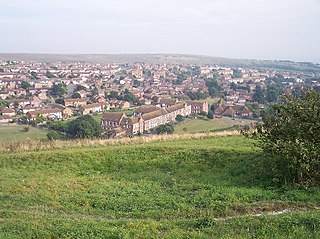
Whitehawk is a suburb in the east of Brighton, England, south of Bevendean and north of Brighton Marina. The area is a large, modern housing estate built in a downland dry valley historically known as Whitehawk Bottom. The estate was originally developed by the local council between 1933 and 1937 and included nearly 1,200 residences. Subsequently, the Swanborough flats were built in 1967, and in the 1970s and 1980s much of the estate was rebuilt by altering the road layouts and increasing the number of houses. Whitehawk is part of the East Brighton ward of Brighton and Hove City Council.

Carmel College was founded in 1948 as a British, Jewish boarding school for boys, modelled on British public schools. In later years it was, to some extent, co-educational, and there were a few non-Jewish day pupils. It closed down in 1997.

Kemp Town railway station was the terminus station of the Kemp Town branch line, a short branch line serving the Kemptown district of Brighton, England.
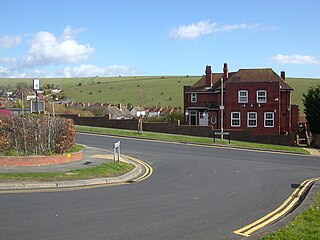
Woodingdean is an eastern suburb of the city of Brighton and Hove, East Sussex, separated from the main part of the city by downland and the Brighton Racecourse. The name Woodingdean came from Woodendean Farm which was situated in the south end of what is now Ovingdean.

Hangleton is a suburb of Brighton and Hove, in the ceremonial county of East Sussex, England. The area was developed in the 1930s after it was incorporated into the Borough of Hove, but has ancient origins: its parish church was founded in the 11th century and retains 12th-century fabric; the medieval manor house is Hove's oldest secular building. The village became depopulated in the medieval era and the church fell into ruins, and the population in the isolated hilltop parish only reached 100 in the early 20th century; but rapid 20th-century development resulted in more than 6,000 people living in Hangleton in 1951 and over 9,000 in 1961. By 2013, the population exceeded 14,000.
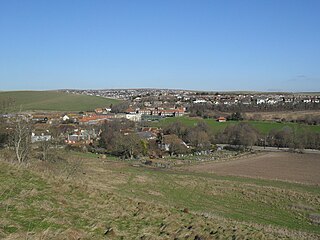
Ovingdean is a small, formerly agricultural village and former civil parish on the eastern edge of the city of Brighton and Hove in the ceremonial county East Sussex, England. In 1921 the parish had a population of 476. On 1 April 1928 the parish was abolished and merged with Brighton.

Mile Oak is a locality forming the northern part of the former parish of Portslade in the northwest corner of the city of Brighton and Hove, England. Now mostly residential, but originally an area of good-quality agricultural land, it covers the area north of Portslade village as far as the urban boundary.

Varndean School is a secondary school serving a large area of Brighton, England.

Dorothy Stringer School is a secondary school located in Brighton, East Sussex, England. It has over 1,600 pupils and 115 members of staff. There are 64 forms, each with an average of 26 students.
Cardinal Newman Catholic School is an 11–18 voluntary aided comprehensive school located in Hove, East Sussex, England. It is a Catholic mixed comprehensive; established to serve the many parishes that lie on the coastal band between Newhaven and Seaford in the east and Shoreham in the west.

St George's Church is an Anglican church in the Kemptown area of Brighton, in the English city of Brighton and Hove. It was built at the request of Thomas Read Kemp, who had created and financed the Kemp Town estate on the cliffs east of Brighton in the early 19th century, and is now regarded as the parish church of the wider Kemptown area. It is a Grade II listed building.

There are 24 Grade I listed buildings in the city of Brighton and Hove, England. The city, on the English Channel coast approximately 52 miles (84 km) south of London, was formed as a unitary authority in 1997 by the merger of the neighbouring towns of Brighton and Hove. Queen Elizabeth II granted city status in 2000.

Brighton and Hove, a city on the English Channel coast in southeast England, has a large and diverse stock of buildings "unrivalled architecturally" among the country's seaside resorts. The urban area, designated a city in 2000, is made up of the formerly separate towns of Brighton and Hove, nearby villages such as Portslade, Patcham and Rottingdean, and 20th-century estates such as Moulsecoomb and Mile Oak. The conurbation was first united in 1997 as a unitary authority and has a population of about 253,000. About half of the 20,430-acre (8,270 ha) geographical area is classed as built up.
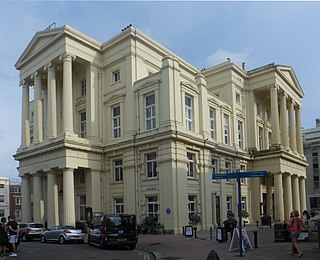
Brighton Town Hall stands on Bartholomew Square in Brighton, East Sussex, England. The town hall contains a number of police cells which were in use until the 1960s, and which now form the Old Police Cells Museum. The town hall is a Grade II listed building. It was formerly the headquarters of Brighton Borough Council and is still used for some meetings of the successor Brighton and Hove City Council.

Arundel Terrace is a road in Kemp Town, Brighton, containing 1–13 Arundel Terrace, a row of Grade I listed buildings; numbers 12–13 are known as Arundel House. The buildings were built between 1824 and 1828 by Amon Wilds and Charles Busby.
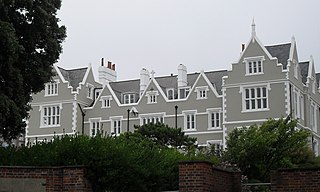
St Mary's Hall,Brighton, Sussex, England, was a private secondary girls' school from 1836 to 2009.


























